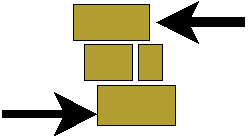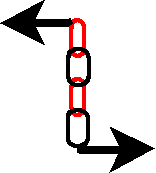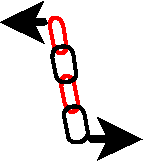Gaudi's models
Viollet le Duc thought that shape (i.e. structure) should be adapted to the materials
used. He appraciated gothic architecture as the most effective technic ever found to build
stone cathedrals (large, high and lighty building). Gaudi founded a way even more
effective for stone constructions. His way can be considered as the most effective way
using some physical properties (it minimizes the shearing forces which are the causes of
collapses). He found the way not using math as I will to demonstrate what I do assess but
models that took naturally the optimum shape by putting them upside down. As you know it,
Gaudi was very fond of nature and nature inspires his work very much. Once again natural
shapes have proven to be effective and tightly linked to efficient structures.
Gaudi used models in several buildings including the Colegio Teresiano, The Guell
crypt, the Sagrada Familia (only towers have been built so the "parabolic"
structure is not visible). The "parabolic" archs are used in almost every
building by Gaudi.
Comparison between stone works and chains
Gaudi's models
Gaudi used some models to test his structures. I have seen few pictures of them but I
have never read any description of there fabrication. I have some ideas about it and I
will try to explain how Gaudi or anyone else could have "calculate" a safe large
stone structure without any computer.
Take chains with little link, glue, a large board. That's all. Oh, I was forgotten that
you need not to be on the space shuttle. Just stay on earth, it will be easier than on the
moon.
The trick to change compression into extension is to use gravity force. It is to put the
stone work structure upside down to obtain a chain structure and reciprocally. 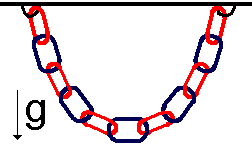
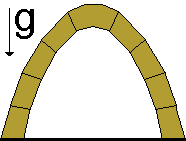
How can a "pseudo parabolic" arch be a "naturally efficient"
structure for stone work
It is the first exercise with our model, making the simplest stone structure: an arch.
Take a chain with small links and glue its two extremities to your bedroom ceiling (it
works also in your bathroom). You will find thanks to our transformation above (i.e.
downside up) an optimal shape for your arch. Playing with the length of the chain, and the
distance between the two extremities, you can obtain different shapes for arches.
- These chains shapes are in fact not parabolic but hyperbolical cosinus shapes, I don't
know if there is an adjective for it so I will call it pseudo parabolic. If you are
interested, you can read the demonstration below. This demonstration requires basic
knowledge in physics (equilibrium laws) and 1st to 2nd year highschool in math (tangente,
curve absice, differential equations). I have tried to go into deep detail so someone
without this knowledge could understand (with derivative knowledge only). (deep detail but
not rigorous details, sorry for math fanatics).
The system is constitued by the ceiling (an horizontal plan named P), Two glue points G
and G' that belong to P, and a chain with "very little links" that is glued by
its two extremities to G and G'. is the curve absice of the chain, is the
linear mass. The system has two orthogonal symetry plans which are (the set of points
at equidistance of the two glue points G and G') and P2 (the spawn(ed?) by and , and
at home it's the plan of your computer screen). Of these considerations of symetry, We can
conclude that the solution is also include in the plan P2 (i.e. your screen) and is
symetrical by the mediatrice of [GG'] (i.e. the vertical line going by the middle of GG').
Two axes: horizontal ox, vertical oy with their associated unity vectors and
Let us consider the subsystem of the chain between -l and l. This system is also
symetrical and immobile. We can apply to it the law of the equilibrium of forces. gravity
P=-2lmlgj, F(l)=Fx(l)i+Fy(l)j and F(-l)=Fx(-l)i+Fy(-l)j.
Projecting on the axe oy, we get the equation: -Fy(-l)+Fy(l)-2lmg=0.
We can add for symetry reasons that Fy(l)=-Fy(-l) so the equation
becomes 2Fy(l)=2lmg that is Fy(l)=lmlg. 
Let us now consider the sub system composed of only one link. It is still in
equilibrium so on ox axe we get Fx(l)-Fx(l+dl)=0 i.e. Fx(l)=Fx(l+dl)
from link to link, we have Fx(l)=C1 whatever the value of l. 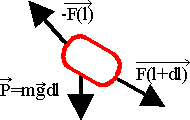
As the link is small, the tangente at point P(l) (called T(l)) is colinear to F(l). So
we can write the definition of colinearity between T(l) and F(l):
(1) y'(x)=dy/dx=C2*mlgl/C1
We now aim at eliminating l in function of y and x. We will use the Pytagorus theorem
dl2=dx2+dy2. This leads to dl/dx=sqrt(dy/dx2+1).
We can derive (1): y''(x)=C2/C1*mgdl/dx and use the expression of dl/dx to give
(2): y''(x)=C3*sqrt(dy/dx2+1)
We will now make a variable change: we can assume that a function t exists where
y'(x)=sh(t(x)) (sh is the hyperbolic sinus). That implies y''(x)=t'(x)ch(t(x)) applying
the drivation law for conpouded functions. (2) can be rewrote as
(3) t'(x)ch(t(x))=C3*sqrt(sh2(t(x))+1)
Now let us use the relationship between sh and ch: ch2-sh2 =1. we
get
(4) t'(x)=C3
so t(x)=C3*x+C4 and replacing t in (3)
(5) y'(x)=sh(C3*x+C4)
Finally y(x)=C5*ch(C3*x+C4)/C3. And because y(0)=0 we can calculate that C4=0. So
where K=C5/C3.
Notes and Definitions:
- sqrt is the square root.
- Pytagorus theorem says that in a rectangle triangle, the square of the
hypothenuse is equal to the sum of the squares of the two others "cotes"
- sh is the hyperbolic sinus. Here are two equivalent definitions: 1) sh(x) is the
odd part of ex, 2) sh(x)=(ex- e-x)/2. It is called sinus
because most of the trigonometrical formulas can be derived into sh and ch formulas. This
is due to the fact that sin(x) is the imaginate part of eix.
- ch is the hyperbolic cosinus. Here are two equivalent definitions: 1) ch(x) is
the even part of ex, 2) ch(x)=(ex+ e-x)/2. It is called
cosinus because most of the trigonometrical formulas can be derived into sh and ch
formulas. This is due to the fact that cos(x) is the real part of eix.
Generalization to take into account filling walls
The former calculus took into account only the structure. It is possible to take into
account also the filling walls. It is to change the link mass from ml g dl into
ml g dl+mwy where mw is the mass per surface unit of the
wall. This modifies (1) into
(1') y'(x)=dy/dx=C2*mlgl/C1+C2*mwy/C1
I do not know how to solve simply those kind of differential equation but Gaudi knew
how to do it without math: he evaluated the mass of the wall and then hang some little
weights to the links to simulate the weight of the walls.
I hope you had fun in reading this.

 RSS
RSS
